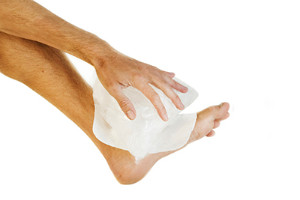Copyright © Michigan Foot and Ankle | Site Map | Nondiscrimination Policy | Design by: Podiatry Content Connection
June 2017
Marathon Runner Emilie Reas Goes Shoeless?
 Although Emilie Reas of San Diego loves to run, there is something about her running that makes her stand out from everyone else. Reas has been able to run different marathons all while being barefoot. After discovering in 2013 that barefoot running can reduce injuries, Reas has opted to stop wearing shoes when she competes. There is a difference in biomechanics between barefoot runners compared to runners who wear sneakers. People who wear sneakers are more likely to land on the heels of their feet when they step, while barefoot runners tend to land on their forefeet.
Although Emilie Reas of San Diego loves to run, there is something about her running that makes her stand out from everyone else. Reas has been able to run different marathons all while being barefoot. After discovering in 2013 that barefoot running can reduce injuries, Reas has opted to stop wearing shoes when she competes. There is a difference in biomechanics between barefoot runners compared to runners who wear sneakers. People who wear sneakers are more likely to land on the heels of their feet when they step, while barefoot runners tend to land on their forefeet.
Barefoot running has its own share of benefits and disadvantages. If you have any concerns about your feet or ankles, contact one of our podiatrists from Michigan Foot and Ankle. Our doctors will treat your foot and ankle needs.
Barefoot Running
The Impact of Barefoot Running
- Running without shoes changes the motion of your running, as most running is done by landing on the heel of the feet.
- Running barefoot requires a different way of running; the landing is done on the front part of the feet.
The Advantages of Barefoot Running
- When running and landing on the front feet, the impact on the feet and ankle is reduced; this can reduce stress injuries.
- It strengthens muscles in the feet, ankles and lower legs.
- Balance of the body is improved, and there is a greater sensory input from the feet to the rest of the body.
The Drawbacks of Barefoot Running
- No protection while running, makes it likely that runners will land on sharp objects and scrapes, bruises and cuts on the feet will result.
- Blisters may form.
- Possibility of plantar fascia problems.
- Risk of getting Achilles tendonitis.
So, what can runners do to make barefoot running safe? It’s best to make a slow transition from running shoes to barefoot running. Once the feet begin to adjust, try walking, then jogging and gradually increasing the distance. Minimalist running shoes may also be an option.
If you have any questions please feel free to contact one of one of our offices located in Ferndale, and Milford, MI . We offer the newest diagnostic and treatment technologies for all your foot and ankle needs.
Ingrown Toenail Prevention
 Ingrown toenails occur when the corner or side of the toenail starts to grow into the soft flesh that surrounds it. As a result, one may experience pain, redness, swelling, and infection. People who have diabetes or poor circulation in their feet may be at a greater risk of developing an ingrown toenail. In order to prevent getting an ingrown toenail, you should try to cut your toenail straight across instead of in a rounded shape. Wearing shoes that fit properly may also help avoid the development of ingrown toenails. It is possible that the pain you experience from an ingrown toenail may spread to other parts of your feet, so it is crucial that you seek assistance from a podiatrist.
Ingrown toenails occur when the corner or side of the toenail starts to grow into the soft flesh that surrounds it. As a result, one may experience pain, redness, swelling, and infection. People who have diabetes or poor circulation in their feet may be at a greater risk of developing an ingrown toenail. In order to prevent getting an ingrown toenail, you should try to cut your toenail straight across instead of in a rounded shape. Wearing shoes that fit properly may also help avoid the development of ingrown toenails. It is possible that the pain you experience from an ingrown toenail may spread to other parts of your feet, so it is crucial that you seek assistance from a podiatrist.
Ingrown toenails can become painful if they are not treated properly. For more information about ingrown toenails, contact one of our podiatrists of Michigan Foot and Ankle. Our doctors can provide the care you need to keep you pain-free and on your feet.
Ingrown Toenails
Ingrown toenails occur when a toenail grows sideways into the bed of the nail, causing pain, swelling, and possibly infection.
Causes
- Bacterial infections
- Improper nail cutting such as cutting it too short or not straight across
- Trauma to the toe, such as stubbing, which causes the nail to grow back irregularly
- Ill-fitting shoes that bunch the toes too close together
- Genetic predisposition
Prevention
Because ingrown toenails are not something found outside of shoe-wearing cultures, going barefoot as often as possible will decrease the likeliness of developing ingrown toenails. Wearing proper fitting shoes and using proper cutting techniques will also help decrease your risk of developing ingrown toenails.
Treatment
Ingrown toenails are a very treatable foot condition. In minor cases, soaking the affected area in salt or antibacterial soaps will not only help with the ingrown nail itself, but also help prevent any infections from occurring. In more severe cases, surgery is an option. In either case, speaking to your podiatrist about this condition will help you get a better understanding of specific treatment options that are right for you.
If you have any questions please feel free to contact one of our offices located in Ferndale, and Milford, MI . We offer the newest diagnostic and treatment technologies for all your foot and ankle needs.
Mariner’s Jean Segura Suffers Ankle Sprain
 Jean Segura of the Seattle Mariners recently sprained his ankle in a game against the Rockies. The shortstop said that “It was feeling really bad the first day,” and that he’s been feeling “much better” in the days following the injury. He suffered the ankle injury during the fourth inning as he slid into second base attempting to advance on a sac fly. Segura who batted .341 so far this season with an OPS of .391 has been called “impossible” to replace by minor leaguer Tyler Smith. His presence will surely be missed by the Mariners and Segura is eager to begin rehab so he can rejoin the team as soon as possible.
Jean Segura of the Seattle Mariners recently sprained his ankle in a game against the Rockies. The shortstop said that “It was feeling really bad the first day,” and that he’s been feeling “much better” in the days following the injury. He suffered the ankle injury during the fourth inning as he slid into second base attempting to advance on a sac fly. Segura who batted .341 so far this season with an OPS of .391 has been called “impossible” to replace by minor leaguer Tyler Smith. His presence will surely be missed by the Mariners and Segura is eager to begin rehab so he can rejoin the team as soon as possible.
Ankle sprains are common but need immediate attention. If you need your feet checked, contact one of our podiatrists from Michigan Foot and Ankle. Our doctors can provide the care you need to keep you pain-free and on your feet.
How Does an Ankle Sprain Occur?
Ankle sprains take place when the ligaments in your ankle are torn or stretched beyond their limits. There are multiple ways that the ankle can become injured, including twisting or rolling over onto your ankle, putting undue stress on it, or causing trauma to the ankle itself.
What Are the Symptoms?
- Mild to moderate bruising
- Limited mobility
- Swelling
- Discoloration of the skin (depending on severity)
Preventing a Sprain
- Wearing appropriate shoes for the occasion
- Stretching before exercises and sports
- Knowing your limits
Treatment of a Sprain
Treatment of a sprain depends on the severity. Many times, people are told to rest and remain off their feet completely, while others are given an air cast. If the sprain is very severe, surgery may be required.
If you have suffered an ankle sprain previously, you may want to consider additional support such as a brace and regular exercises to strengthen the ankle.
If you have any questions please feel free to contact one of our offices located in Ferndale, and Milford, MI . We offer the newest diagnostic and treatment technologies for all your foot and ankle needs.
Ole Miss’s Kessinger Suffers Foot Fracture
 Ole Miss recently endured a big loss when they learned their shortstop had suffered a broken foot. Shortstop Greg Kessinger is expected to miss the rest of the season with the injury. Kessinger had an x-ray on his foot which revealed the fracture, however his surgery to repair it has not been scheduled. The young shortstop suffered the injury while playing ping-pong in the players lounge at the SEC Tournament. He had been the everyday shortstop all season, hitting .175, with 2 home runs, 5 doubles and 16 RBIs.
Ole Miss recently endured a big loss when they learned their shortstop had suffered a broken foot. Shortstop Greg Kessinger is expected to miss the rest of the season with the injury. Kessinger had an x-ray on his foot which revealed the fracture, however his surgery to repair it has not been scheduled. The young shortstop suffered the injury while playing ping-pong in the players lounge at the SEC Tournament. He had been the everyday shortstop all season, hitting .175, with 2 home runs, 5 doubles and 16 RBIs.
A broken foot requires immediate medical attention and treatment. If you need your feet checked, contact one of our podiatrists from Michigan Foot and Ankle. Our doctors can provide the care you need to keep you pain-free and on your feet.
Broken Foot Causes, Symptoms, and Treatment
A broken foot is caused by one of the bones in the foot typically breaking when bended, crushed, or stretched beyond its natural capabilities. Usually the location of the fracture indicates how the break occurred, whether it was through an object, fall, or any other type of injury.
Common Symptoms of Broken Feet:
- Bruising
- Pain
- Redness
- Swelling
- Blue in color
- Numbness
- Cold
- Misshapen
- Cuts
- Deformities
Those that suspect they have a broken foot shoot seek urgent medical attention where a medical professional could diagnose the severity.
Treatment for broken bones varies depending on the cause, severity and location. Some will require the use of splints, casts or crutches while others could even involve surgery to repair the broken bones. Personal care includes the use of ice and keeping the foot stabilized and elevated.
If you have any questions please feel free to contact one of our offices located in Ferndale, and Milford, MI . We offer the newest diagnostic and treatment technologies for all your foot and ankle needs.






